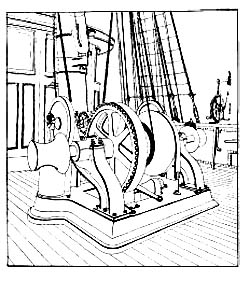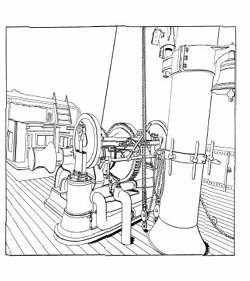
by Dean C. Allard

|
 |
|
Figure
7. - The Albatross dredging engine views. |
3) Major economic benefits would accrue to the nation’s
seafaring industry by increasing the yield of American fisheries.
4) The development of U.S. fisheries could make use of the British
North American inshore fisheries unnecessary.
5) Albatross was a national security asset since, in
case of need, she could be taken over by the Navy for use as a
warship. In fact, this did occur during the Spanish American War
and World War I.
6) And finally, Baird acknowledged his basic scientific interest
when he stated: “As incidental to the economical inquiry,
but of very great interest to the naturalist,” the ship
will collect “objects of natural history in large quantity
otherwise unobtainable” (USFC, 1884a:xxv–xxxi).
In 1882 Congress once again granted Baird’s request. In
that year the Fish Commissioner not only received $42,000 in new
funds for the ship, he also secured a $45,000 appropriation for
the vessel’s equipment. In all, a sum of $190,000 now was
in hand to construct the Albatross (USFC, 1884b:xxvi–xxvii).
Bearing in mind what this amount is worth in modern dollars, not
to mention the great difficulty the U.S. Navy encountered during
the early 1880’s in obtaining appropriations for any new
warship construction, one must be impressed by Baird’s political
skill in securing funding for the Albatross.
The Pusey and Jones Shipyard in Wilmington, Del., which previously
built Baird’s Fish Hawk, received the Albatross
contract on 28 March 1882. Charles Copeland supervised the
yard’s work. He was assisted by Lieutenant Commander Zera
L. Tanner, U.S. Navy, the prospective commander of the ship’s
Naval crew. That officer had considerable experience with marine
exploration as the first commander of the Fish Hawk and
through an earlier assignment with the Navy’s Hydrographic
Office.
Tanner was primarily responsible for selecting and installing—and
in some cases personally designing—the trawl nets, rake
and grapnel dredges, tangles, surface nets, and other collecting
devices, as well as the ship’s thermometers, salinometers,
and sounding equipment (Fig. 8, 9) (Tanner, 1885; USFC, 1884b).
According to Baird’s associate, George Brown Goode (Goode
and Bean, 1895: I,vi), the trawl nets carried by the Albatross
were of particular since they represented a major advance in the
ability to collect deepsea specimens, a task previously undertaken
with metal dredges.
|

